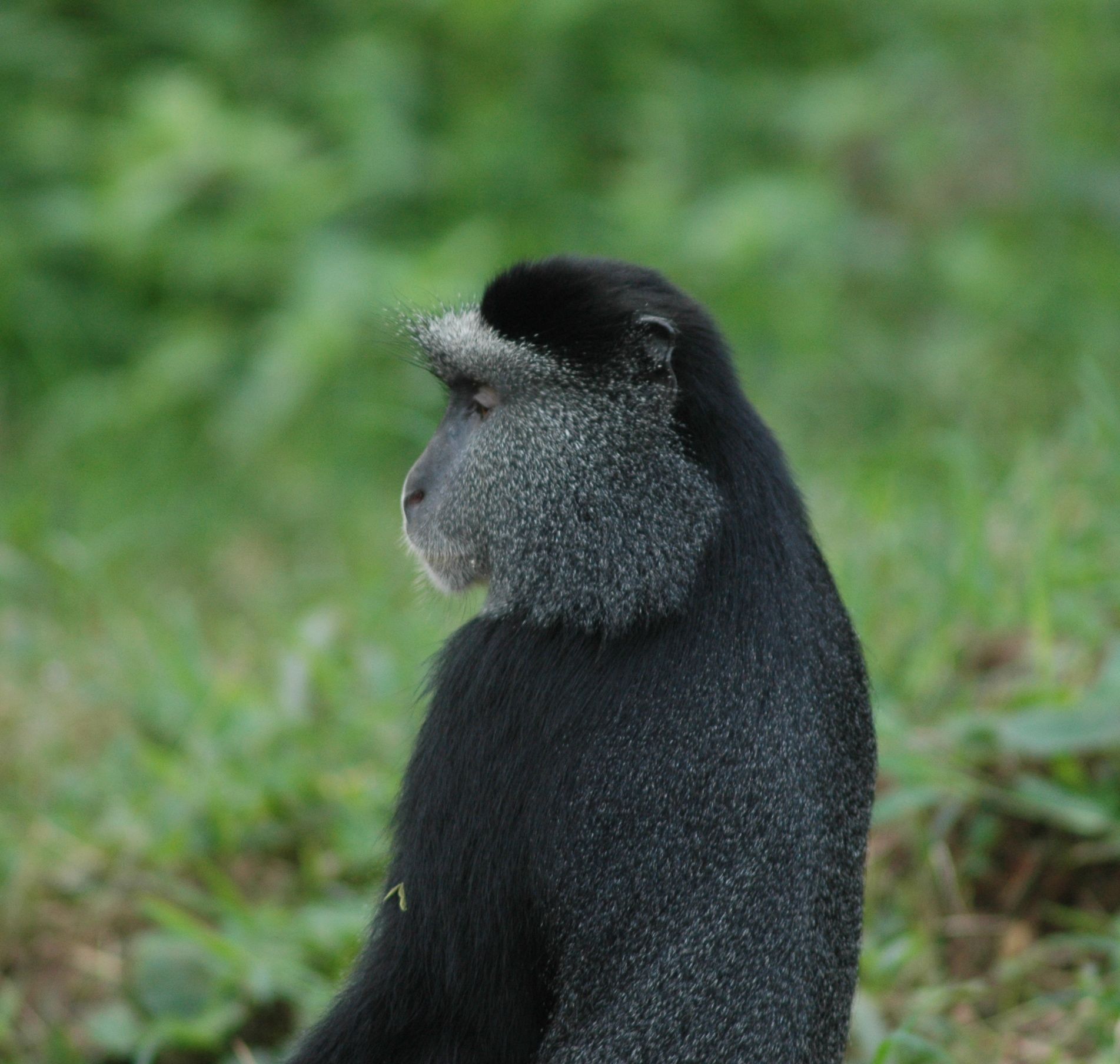 |
MATING STRATEGIES AND MATING SYSTEMS |
 A highly vigilant male
blue monkey. |
Study of the connection between social behavior and reproduction reflects
a "functional" or "ultimate" orientation toward behavior. I have
conducted a long-term study of reproductive strategies and the mating
system in blue monkeys (Cercopithecus mitis) which developed
from surprising serendipitous discoveries we
made about their behavior some time ago (when I was a graduate
student).
This species had been viewed as exemplifying a "harem polygynous"
mating
system, as individuals are normally found living in groups containing a
single
adult male, multiple adult females, and young. Our observations
revealed, however, that the resident male is not the only
male to mate in the group, and he does not necessarily achievemost
matings.
Other males visit the group for varying periods and in varying ways
(some surreptitiously, others more conspicuously), and mate with the
group’s females.
Females appear to play an active role in determining patterns of mating
as they persistently solicit the attentions of certain males (usually
newcomers) while avoiding others. This behavior seems
unexpectedly dynamic for a species once thought to exemplify harem
polygyny, but its interpretation has been difficult because the
reproductive consequences of being a resident male or a temporary
intruder are not known. The fact that female mating is not
closely tied to conception (see Karen Pazol’s
work) makes things even more
complicated!
Behavioral ecologists studying many animal species have generally viewed male social strategies (i.e. whether they live with females) as direct consequences of their mating strategies. In birds, however, it is now well known that social and reproductive units often do not coincide, and there is increasing evidence, primarily behavioral, for a similar non-correspondence in mammals, including primates. Where such disjunction occurs, new questions arise about why males reside with females at all, and what other factors might determine their reproductive success.
Jeff Hatcher and Su-jen Roberts assessed paternity genetically (using microsatellite loci), with data from multiple groups over multiple years. After initial challenges working with the degraded DNA in fecal samples, which can however be gathered non-invasively, we verified that resident males are losing about 60% of the paternities in their own groups to outside males. The outsiders are both neighboring residents and "bachelors." The loss occurs regardless of whether the group is experiencing a 'multi-male influx' during the breeding season. Note that the resident male is invariably socially dominant, yet it seems impossible for him to keep a monopoly on female matings, especially in a visually dense habitat and when groups are large. Females show every indication of having a sexual interest in unfamiliar males as well.
Among non-resident males, Su-Jen's work showed that neighboring resident (who are highest ranking among non-residents) have priority over bachelors, whereas bachelor rank does not predict their success vis a vis other bachelors. These results suggest that the bachelor strategy is highly opportunistic, which agrees with behavioral observations in the field.
We have also conducted some studies of female mate choice. So far they aren't conclusive: some evidence suggests that females are actively choosing mating partners at a behavioral level, but evidence that this is influencing paternity is not so convincing.
Our behavioral data from multiple years can also be used to understand the variation in the occurrence of multi-male influxes during the breeding season. It now seems clear that female defendability is critical: when more females are sexually active, a single male has a harder time monopolizing them. A second variable that is important is male intruder pressure, but we are still unsure of the factors that cause variation in this parameter.
Behavioral ecologists studying many animal species have generally viewed male social strategies (i.e. whether they live with females) as direct consequences of their mating strategies. In birds, however, it is now well known that social and reproductive units often do not coincide, and there is increasing evidence, primarily behavioral, for a similar non-correspondence in mammals, including primates. Where such disjunction occurs, new questions arise about why males reside with females at all, and what other factors might determine their reproductive success.
Jeff Hatcher and Su-jen Roberts assessed paternity genetically (using microsatellite loci), with data from multiple groups over multiple years. After initial challenges working with the degraded DNA in fecal samples, which can however be gathered non-invasively, we verified that resident males are losing about 60% of the paternities in their own groups to outside males. The outsiders are both neighboring residents and "bachelors." The loss occurs regardless of whether the group is experiencing a 'multi-male influx' during the breeding season. Note that the resident male is invariably socially dominant, yet it seems impossible for him to keep a monopoly on female matings, especially in a visually dense habitat and when groups are large. Females show every indication of having a sexual interest in unfamiliar males as well.
Among non-resident males, Su-Jen's work showed that neighboring resident (who are highest ranking among non-residents) have priority over bachelors, whereas bachelor rank does not predict their success vis a vis other bachelors. These results suggest that the bachelor strategy is highly opportunistic, which agrees with behavioral observations in the field.
We have also conducted some studies of female mate choice. So far they aren't conclusive: some evidence suggests that females are actively choosing mating partners at a behavioral level, but evidence that this is influencing paternity is not so convincing.
Our behavioral data from multiple years can also be used to understand the variation in the occurrence of multi-male influxes during the breeding season. It now seems clear that female defendability is critical: when more females are sexually active, a single male has a harder time monopolizing them. A second variable that is important is male intruder pressure, but we are still unsure of the factors that cause variation in this parameter.